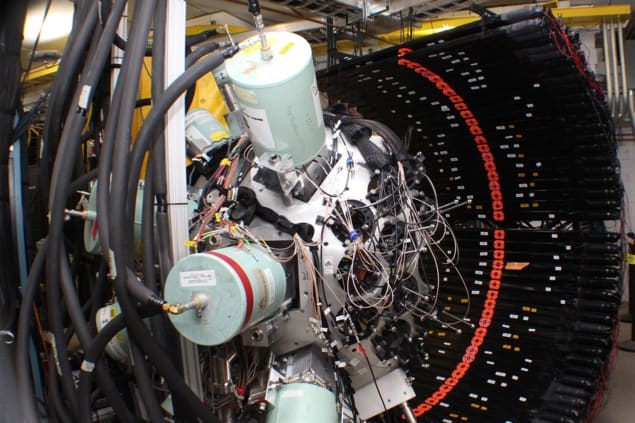
The first scientific results from the new Facility for Rare Isotope Beams (FRIB) at Michigan State University have been unveiled by physicists in the US. Heather Crawford at Lawrence Berkeley National Laboratory and colleagues have synthesized new neutron-rich isotopes of three different elements. Each nuclei is near the neutron drip line and the team has measured the isotopes’ lifetimes for the first time. The research provides a taste of how physicists will use FRIB to study exotic nuclei.
Costing $730m, FRIB opened earlier this year with the aim of expanding our knowledge of nuclear physics by creating thousands of new isotopes for scientists to study. FRIB comprises a superconducting linear accelerator that can create high-intensity beams of just about every stable isotope. These nuclei are fired at targets, creating unstable isotopes that are collected to form beams – allowing the isotopes to be studied.
Dripping out
Nuclei contain protons and neutrons and there is a limit on the number of neutrons that can exist in the isotopes of a given element. When known nuclides are plotted with proton number on the vertical axis and neutron number on the horizontal axis, this neutron limit appears as a lower boundary line. This is called the drip line, the idea being that near to this line, neutrons drip out of neutron-heavy nuclei. Isotopes lying close to this line are all highly unstable and have very short lifetimes, making them very difficult to study.
The neutron drip line’s position has been charted for the first 10 elements: from hydrogen-7 to neon-34. Yet for the rest of the periodic table, isotopes lying close to the line are so unstable that they have so far escaped detection in experiments.
New exotic nuclei
In this first experiment at FRIB, Crawford and colleagues fired a beam of calcium-48 nuclei at a beryllium target. This created five new exotic nuclei – isotopes of phosphorous, magnesium, aluminium, and silicon – all of which lie close to the neutron drip line and contain about 28 neutrons. The team also created several other nuclei that have been studied before.

Biggest expansion of known chemical universe targeted by FRIB nuclear facility
The team measured the half-lives of the nuclei using an instrument called the FRIB Decay Station Initiator, and then compared their results with theoretical predictions. In most cases, there was agreement, but the team describes as “intriguing” the shorter-than-expected half-life of magnesium-38. This result will require a tweaking of the current shell model of the nucleus.
Crawford’s team will do new experiments next year, when a much higher beam intensity should give them access to additional neutron-rich isotopes. In the meantime, other research groups are using the facility and we should see more studies of new and exotic nuclei.
The research is described in Physical Review Letters.
- SEO Powered Content & PR Distribution. Get Amplified Today.
- Platoblockchain. Web3 Metaverse Intelligence. Knowledge Amplified. Access Here.
- Source: https://physicsworld.com/a/five-new-exotic-nuclei-revealed-in-first-experiment-at-frib/



